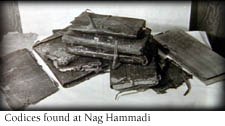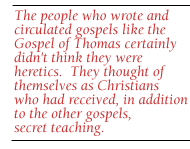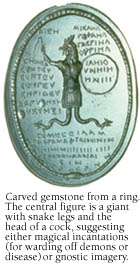Gnostics and Other Heretics
Early documents suggest the first Christian communities had radically different interpretations of the meaning of Jesus' life and teachings.The Harrington Spear Paine Foundation Professor of Religion Princeton University
Gnostic texts of nag hammadi
 The discovery at Nag Hammadi began with an Arab villager whose name was
Mohammed Ali going with his brothers on an ordinary errand. They saddled up
their camels and they rode out from their village, a small town in the barren
stretches of upper Egypt. They took their camels and rode up to a cliff nearby,
which is honeycombed with thousands of caves. These caves were used as burial
caves in antiquity, thousands of years ago. But they were digging under the
cliffs for fertilizer, that is, for bird droppings which fertilized the crops.
And Mohammed Ali said he struck something when he was digging underground.
And, curious, he kept digging, and he was startled to find a six foot jar
sealed. And next to it was buried a corpse. Mohammed Ali said he hesitated to
break the jar because he thought there might be a jinn in it. But hope
overcame fear; he said he picked up his mattock and smashed the jar, and saw
particles of gold fly out of it, much to his delight. But a moment later he
realized it was only fragments of papyrus. Inside the jar were 13 volumes,
bound in tooled gazelle leather. Thirteen volumes of papyrus text. Now
Mohammed Ali could not read these texts. He doesn't read Arabic, which is his
own language. And these texts were in some strange archaic language. They
were actually Coptic, which is the Egyptian language of 1400 years ago. But he
nevertheless put them in his backpack, slung them along and took them home and
threw them on the ground in his house near the stove. Later his mother said
that she took some of them and threw them into the fire for kindling when she
was baking bread. What we didn't know until much later is that these contained
some of the most precious texts of the 20th century. That they have uncovered
for us a whole new way of seeing the early Christian world.
The discovery at Nag Hammadi began with an Arab villager whose name was
Mohammed Ali going with his brothers on an ordinary errand. They saddled up
their camels and they rode out from their village, a small town in the barren
stretches of upper Egypt. They took their camels and rode up to a cliff nearby,
which is honeycombed with thousands of caves. These caves were used as burial
caves in antiquity, thousands of years ago. But they were digging under the
cliffs for fertilizer, that is, for bird droppings which fertilized the crops.
And Mohammed Ali said he struck something when he was digging underground.
And, curious, he kept digging, and he was startled to find a six foot jar
sealed. And next to it was buried a corpse. Mohammed Ali said he hesitated to
break the jar because he thought there might be a jinn in it. But hope
overcame fear; he said he picked up his mattock and smashed the jar, and saw
particles of gold fly out of it, much to his delight. But a moment later he
realized it was only fragments of papyrus. Inside the jar were 13 volumes,
bound in tooled gazelle leather. Thirteen volumes of papyrus text. Now
Mohammed Ali could not read these texts. He doesn't read Arabic, which is his
own language. And these texts were in some strange archaic language. They
were actually Coptic, which is the Egyptian language of 1400 years ago. But he
nevertheless put them in his backpack, slung them along and took them home and
threw them on the ground in his house near the stove. Later his mother said
that she took some of them and threw them into the fire for kindling when she
was baking bread. What we didn't know until much later is that these contained
some of the most precious texts of the 20th century. That they have uncovered
for us a whole new way of seeing the early Christian world.
 There were 52 texts altogether, apparently, unless some of them were
burned that we don't know about. And they contain, some of them, secret
gospels, such as the Gospel of Thomas, the Gospel of Philip. The Gospel of
Mary Magdalene is a similar text that was found separately. They also contain
conversations between Jesus and his disciples.... All kinds of literature from
the early Christian era, a whole discovery of text rather like the New
Testament but also very different.
There were 52 texts altogether, apparently, unless some of them were
burned that we don't know about. And they contain, some of them, secret
gospels, such as the Gospel of Thomas, the Gospel of Philip. The Gospel of
Mary Magdalene is a similar text that was found separately. They also contain
conversations between Jesus and his disciples.... All kinds of literature from
the early Christian era, a whole discovery of text rather like the New
Testament but also very different.
For more on the gnostic texts discovered at Nag Hammadi, read this excerpt from Elaine Pagels' The Gnostic Gospels. Plus, read excerpts from the gnostic Gospel of Thomas and the Gospel of Mary Magdalene.
GNOSTICISM
The term gnosticism is often used as a sort of umbrella term to cover the people that the leaders of the church don't like. It covers probably a huge variety of points of view. And yet there is a theme; the way I connect text that we think of as gnostic is the sense that the divine is to be discovered by some kind of interior search, and not simply by a savior who is outside of you.
How does one demonstrate that one has acquired a secret knowledge? How did the gnostics themselves demonstrate and understand this secret inner knowledge?
Many, many Christians, who are not appreciated by many of the leaders of the church, believed that spiritual awakening was demonstrated in one's capacity to speak in either revelation or dream visions.... Such Christians often spoke in poems, in songs, in stories that we would say come out of the creative imagination or the religious imagination. Fathers of the church objected and said, "Well, they're just making up a lot of garbage. It's a ridiculous thing that they are just inventing themselves out of their own feelings." But as they saw it, the sense of an original voice, an original insight, is as we would see it, say, in a creative writing class today, was evidence that that person has discovered his or her genuine voice.
Did the gnostics see themselves as being outside?
The people who wrote and circulated gospels like the Gospel of Thomas certainly didn't think they were heretics. They thought of themselves as Christians who had received, in addition to the other gospels, secret teaching. For example in the 4th chapter of the Gospel of Mark, Mark says that Jesus taught certain things privately to the disciples. And Paul too says that he had secret teaching. And these claim to give some of the secret teaching of Jesus. Whether he actually did teach secretly or not, we don't know otherwise. But the Gospel of Thomas claims to be this kind of secret teaching.
Did the people who were called the Gnostics survive? What happened to them?
A spokesman for the orthodox church called certain other Christians gnostics. We don't know quite what they mean by that except that they didn't like their viewpoints. The people whom they called gnostics would have called themselves Christian. And they were Christians of very diverse viewpoints. I mean, we think today Christianity looks diverse. If you look from Pentecostal churches to Roman Catholic Churches, to orthodox churches, to every kind of Protestant Church one can imagine, we think that's diversity. But actually most Christians today share a common list of New Testament writings, they share a certain kind of structure of church, and a certain core of beliefs. But back then there was no list of agreed gospels. There was no list of agreed doctrines. And there was no agreed upon structure. So actually the early Christian movement was much more wildly diverse. And perhaps that's why that part of the movement in fact couldn't survive.
"HERETICS" DEFINED IN RESPONSE TO PERSECUTION
As far as we can tell, the earliest Christian communities had an enormous variety of viewpoints and attitudes and approach, as we've said. But by the end of the second century, you begin to see hierarchies of bishops, priests and deacons emerge in various communities and claim to speak for the majority. And with that development, there's probably an assertion of leadership against viewpoints that those leaders considered dangerous and heretical. One of the issues that polarized those communities, perhaps the most urgent and pressing issue, was persecution. That is, these people, all Christians, belonged to an illegal movement. It was dangerous to belong to this movement. You could be arrested, if you were charged with being a Christian, you could be put on trial, you could be tortured and executed if you refused to recant. And with that pressure, many said, "We want to know when a person joins this movement if that person is going to stand with us or is going to pretend they're not with us. So let's clarify who belongs to us...."
The Bishop Irenaeus was about 18 to 20 years old when his little community was absolutely decimated by a devastating persecution. They say that 50 to 70 people in two small towns were tortured and executed. That must have meant hundreds were rounded up and put in prison. But 50 to 70 people in two small towns executed in public is a devastating destruction of that beleaguered community. And Irenaeus was trying to unify those who were left. What frustrating him is that they didn't all believe the same thing. They didn't all gather under one kind of leadership. And he, like others, was deeply aware of the dangers of fragmentation, that one community could be lost. And so it is out of that deep concern, I think, that Irenaeus and others began to try to unify the church, and, and create criteria like, you know, these are the four gospels. These are what we believe, these are the rituals, which you first do. You're baptized and then you're a member of this community. It would be absurd to suggest that the leaders of the church were out to protect their power. Because to become bishop in a church in which the 92 year old bishop had just died in prison, which is what Irenaeus did as a very young man, he had the courage to become bishop, is to become a target for the next persecution. This is not a position of power, it's a position of danger and courage. And those people were concerned to try to unify the church. So it would be ridiculous to tell the story of the early Christian movement as though the orthodox were, you know, power mad, and trying to destroy all diversity in the church. It's much more complicated than that. The sociologist Max Weber has shown that a religious movement, if it doesn't develop a certain institutional structure within a generation of its founder's death, will not survive. So it's likely, I think, that we owe the survival of the Christian movement to those forms that Irenaeus and others developed. You know, the list of acceptable books, the list of acceptable teachings, the rituals.
The Lillian Claus Professor of New Testament Yale Divinity SchoolGNOSTICISM
What is gnosticism? How did it come into being?
Gnosticism is a term that's etymologically connected with the word "to know." It has the same root in English, "kno" is related to "gno" the Greek word for gnosis. And Gnostics were people who claimed to know something special. This knowledge could be a knowledge of a person, the kind of personal acquaintance that a mystic would have with the divine. Or it could be a kind of propositional knowledge of certain key truths. Gnostics claim both of those kinds of knowledge. The claim to have some sort of special knowledge was not confined to any particular group in the second century. It was widespread, and we have such claims being advanced by fairly orthodox teachers such as Clement of Alexandria, we have similar claims being advanced by all sorts of other teachers during that period.
 How did it come into being? How did it develop?
How did it come into being? How did it develop?
It's difficult to know with precision how gnosticism emerged. Because the way we use the term today is as a cover for a variety of phenomena during the course of the second century. One main strand of gnosticism seems to have emerged as a way of reflecting on Jewish scripture and reflecting on Jewish traditions about the descent of the angels to beget children by human beings. Using that old tradition as a way of reflecting on why there's evil in the world. So in one way, gnosticism is a movement that has a philosophical or a theological dimension that's wrestling with the problem of theodicy. And many gnostics solve that problem by saying there's a sharp dichotomy between the world of matter and the world of spirit, and they're very much interested in getting into the world of spirit, removing themselves from the world of matter. They explain that dichotomy with elaborate theories about how spirit got involved with matter and then with practices, usually ascetical practices, to enable spirit to return to its own place.
Why is it seen as a heresy?
By the end of the second century there was considerable debate among Christian teachers, theologians, about how best to articulate Christian belief. Gnostics are charged by their their critics with making a fundamental mistake about the relationship between God as creator and God as redeemer. And they seem to suggest, at least some of them seem to suggest that the divine power that created this world is an inferior being, inferior to the true spiritual God who desires the salvation of all human beings, or at least all of those human beings who are capable of knowledge. That distinction between the belief in creation and belief in redemption was viewed by theologians such as Irenaeus as to be a fundamental mistake which departed radically from the testimony of scripture.
Another thing that gnostics worried about was the relationship between the divine element and the human element in Jesus, and in some cases they seem to have made a similar sort of distinction between the divine and the human that put those into sharp opposition, an opposition that was viewed as a mistake by their critics. By making that distinction they tended to denigrate the physical humanity of Jesus, and orthodox teachers such as Irenaeus by the end of the second century wanted to insist very strongly on the humanity of Jesus as an example for his followers, so it was very important to insist on Jesus as really suffering and dying on the cross because Christians were being called upon at that time to suffer and die as witnesses, as martyrs to their faith. And if with some gnostics you could denigrate the physical suffering of Jesus, you might call into question that obligation to stand and to bear witness for the faith.
What did gnostics believe happened at the time of the crucifixion?
Different gnostics believed different things about the death and resurrection of Jesus. But some were people, whom we know as docetists, [who] believed that the death and suffering of Jesus were things that only appeared to happen, or if they happened, didn't really happen to the core of Jesus' spiritual reality. And so they abandoned the insistence upon those two poles of what were coming to be the heart of orthodox belief, the death and resurrection of Jesus.
How the image of Jesus change in the Gnostic Judeo-Christian tradition?
There are different texts in the opus of material that we call gnostic that are presentations of the teachings of Jesus or the person of Jesus. Some of those texts, such as the Gospel of Thomas, which is at least a semi-gnosticizing kind of production, presents Jesus simply as a teacher, a teacher of wisdom. Someone who did not suffer an ignominious death on the cross and did not experience a resurrection. So the focus on Jesus as teacher would be characteristic of a strand of Christianity that certainly comes to be gnostic.
Another text called the Gospel of Truth is not a narrative of the death and resurrection of Jesus at all. It's a symbolic reflection on certain themes that come from scripture and are associated with the life and teachings of Jesus. But that symbolic reflection is a way of getting the the readers or hearers of that text to think about their relationship to God, their essential connection with the divine and the world of spirit....
What do gnostics think when they hear a hymn like "Thunder, The Perfect Mind?"
The hymn "Thunder, the Perfect Mind" is a series of riddles which make contradictory statements about some sort of mysterious figure. Riddles such as, "I am the mother, and I am the daughter. I am the wife and I am the whore." Well, that kind of text evokes the question, who is the I that's speaking? And so this text probably was a text used to stimulate meditation upon some spiritual principle, whatever that spiritual principle was. The revealer figure, for instance, the divine wisdom that many gnostics saw as an important figure in the history of salvation.
